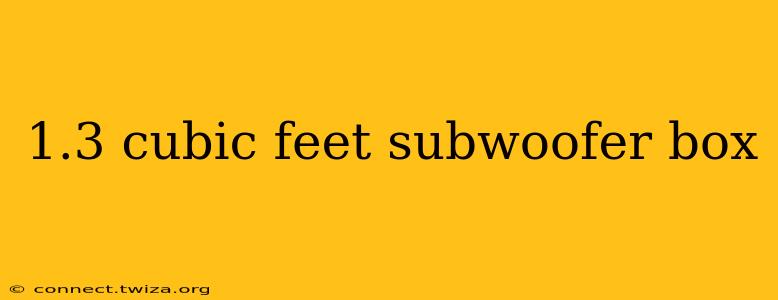Building a subwoofer box is a rewarding project for audio enthusiasts, allowing for precise control over sound quality and system integration. A 1.3 cubic feet subwoofer box is a common size, suitable for a range of subwoofers, but careful planning is essential to ensure optimal performance. This guide delves into the design, construction, and considerations for building a high-performing 1.3 cubic foot subwoofer enclosure.
What Size Subwoofer Fits in a 1.3 Cubic Foot Box?
This is a crucial question. The ideal subwoofer for a 1.3 cubic foot enclosure depends on the subwoofer's specifications, particularly its recommended enclosure size. Manufacturers usually specify the optimal volume for their subwoofers, often listing options for sealed, ported, or bandpass designs. Always consult the subwoofer's manual before proceeding. Ignoring this recommendation can lead to poor bass response, distortion, and even damage to the subwoofer. Some 10-inch and even some 12-inch subwoofers might fit well in a 1.3 cubic foot box, depending on their design and specifications.
What Type of Enclosure is Best for a 1.3 Cubic Foot Subwoofer Box?
Several enclosure types are compatible with a 1.3 cubic foot volume, each offering different sonic characteristics:
-
Sealed (Acoustic Suspension): Sealed boxes are simple to build, offering tight and accurate bass with low distortion. They generally handle less power than ported enclosures but provide a cleaner, more controlled sound. A 1.3 cubic foot sealed enclosure is a good option for subwoofers designed for this type of box.
-
Ported (Bass Reflex): Ported enclosures use a port (tube) to enhance bass output at specific frequencies. This results in louder bass but can also introduce port noise and potentially less accurate bass response if not properly designed. Designing a ported enclosure requires more advanced calculations to determine the optimal port size and tuning frequency. For a 1.3 cubic foot ported box, careful calculations are crucial to avoid excessive port noise or unwanted resonances.
-
Bandpass: Bandpass enclosures are more complex, offering a very specific frequency response but requiring precise calculations and more advanced construction techniques. They are less common for this size of enclosure.
How Much Internal Bracing is Necessary for a 1.3 Cubic Foot Subwoofer Box?
Internal bracing is essential to minimize unwanted resonances and vibrations within the enclosure. For a 1.3 cubic foot box, strategically placed bracing is crucial to maintain rigidity. Consider using 1x3 or 1x4 inch lumber for bracing. The more bracing you add, the stiffer and less resonant the box will be, but more bracing also increases complexity and weight. Aim for a balance that strengthens the box without adding unnecessary weight. Strategic placement is vital; bracing should connect the different panels of the box to form a strong and rigid structure.
What Materials Should I Use to Build a 1.3 Cubic Foot Subwoofer Box?
Common materials include MDF (Medium-Density Fiberboard), plywood, and particleboard. MDF is generally preferred for its density and ability to dampen vibrations. Ensure the material is appropriately thick (at least ¾ inch is recommended) to maintain the integrity of the box and minimize resonances.
Can I Build a 1.3 Cubic Foot Subwoofer Box Myself?
Yes, building a subwoofer box is a manageable DIY project, provided you have basic woodworking skills and tools. Accurate measurements and precise cuts are vital. If you lack experience, it’s always best to practice on scrap wood first. Detailed plans and online calculators can help with design and calculations.
What Tools Will I Need to Build a 1.3 Cubic Foot Subwoofer Box?
You will need tools for cutting, assembling, and finishing your subwoofer box including:
- Measuring tape and square
- Circular saw or jigsaw
- Wood glue
- Screws
- Clamps
- Sandpaper
- Wood filler
- Paint or other finishing materials
By following these guidelines and carefully selecting your subwoofer and enclosure type, you can successfully build a high-quality 1.3 cubic foot subwoofer box that delivers exceptional audio performance. Remember that careful planning, precise construction, and attention to detail are key to achieving optimal results.
